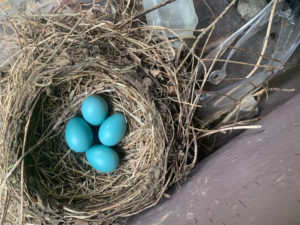 This was supposed to be a column about rose-breasted grosbeaks. When they arrived at my bird feeders a few weeks ago, I was—as always—thrilled to pieces. Though the female grosbeak is unremarkable in appearance (she looks like an oversized sparrow), her male counterpart is stunning. His plumage is black-and-white, which is lovely in itself, but what really makes you do a double-take is the rosy red patch in the middle of his white breast. I’ve heard it described as a triangle or a chevron, but it looks like a heart to me.
This was supposed to be a column about rose-breasted grosbeaks. When they arrived at my bird feeders a few weeks ago, I was—as always—thrilled to pieces. Though the female grosbeak is unremarkable in appearance (she looks like an oversized sparrow), her male counterpart is stunning. His plumage is black-and-white, which is lovely in itself, but what really makes you do a double-take is the rosy red patch in the middle of his white breast. I’ve heard it described as a triangle or a chevron, but it looks like a heart to me.
In spring, grosbeaks migrate from Mexico and South America to breeding grounds as far north as Canada. They hang out in our part of Tennessee from mid-April until mid-May and then again from mid-September until mid-October on their way back to warmer climes.
But before I could write that column, daughter Leigh texted me some pictures from Kentucky. Suddenly, I had an even better bird subject. Robin parents had been busy building a nest on a shelf on Leigh’s back stoop. On April 23, four impossibly beautiful blue eggs appeared. “The mama bird just took a break and we saw these,” Leigh wrote. “She flew back soon after I took the picture and I’m pretty sure she glared at me.”
“Are your kids loving this?” I texted back.
I remembered when granddaughter June, four years old at the time, found a bird’s nest while I was visiting. “Marmie,” she said, “Come look. I found a buwd’s nest.”
“It IS a buwd’s nest!” I exclaimed, because I thought the way she said “bird” without the “r” was about the cutest thing I’d ever heard.
Indignantly, June put her hands on her hips. “It’s not a buwd’s nest,” she said. “It’s a buwd’s nest.” Two years later, she talks more like a grownup, which makes me kind of sad. She and brother Eli have apparently grown somewhat jaded when it comes to the ways of nature. Leigh told me that they weren’t nearly as excited about the baby robin process as she was.
“That’s OK,” I told her. “Your kids have never been a mother.”
On April 5, the text I’d been waiting for arrived. Four of the homeliest little critters I’d ever seen lay huddled together in the nest. Under the picture was this caption: “They are born!!!” And I burst into tears.
I don’t know why. It’s not as though I’ve never seen a baby animal come into this world. In the 25 years I lived on a farm, we had not only baby birds and chicks and ducks and geese but also kittens and puppies and, one wonderful spring, twin baby goats. I don’t ever recall shedding a tear when those animals were born. Why was I crying about baby robins?
Maybe I was releasing pent-up emotion as we move beyond the pandemic. There were times in 2020 when I really and truly wondered if I’d ever see my kids and grandkids in person again. Maybe I cried because I knew that not all of Leigh’s baby robins will survive (only one in four is likely to make it until autumn). Maybe I was thinking about “Opie the Birdman,” my favorite episode of The Andy Griffith Show. (Opie accidentally kills a mother bird with his slingshot and then takes on the task of raising her orphaned babies. I challenge anyone with a heart in their chest not to cry when Pa says “Yeah, but don’t the trees look nice and full.”) Or maybe I was distressed that I’d already e-mailed my column for Mother’s Day weekend to my Herald-Citizen editors and it had nothing to do with Mother’s Day.
So here it is, one week late. Hooray for mothers, birds and otherwise!
(May 15, 2021)